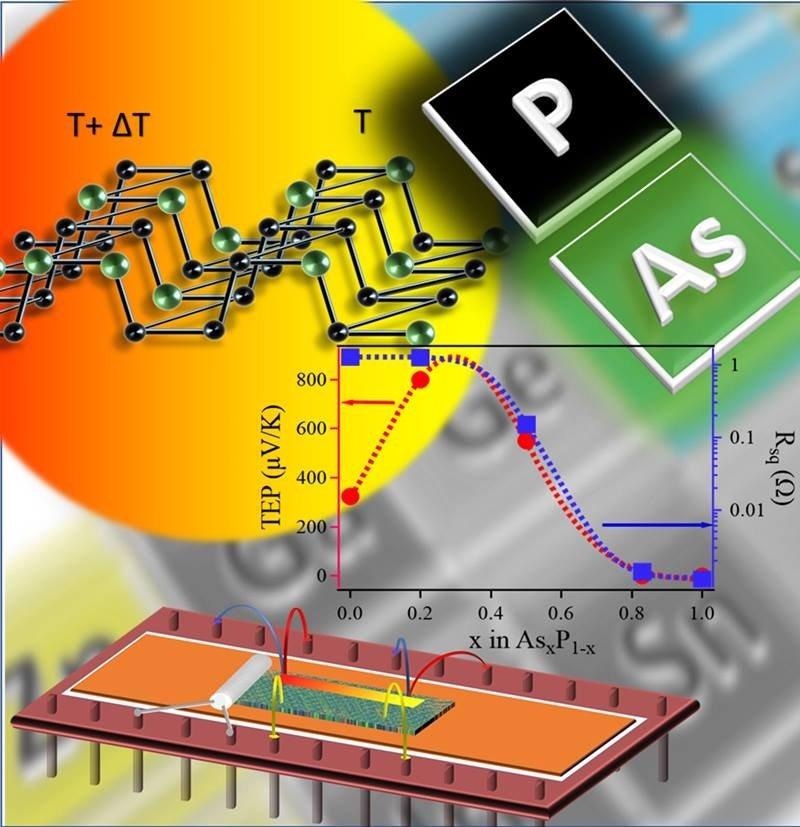The search for thermoelectric materials that efficiently convert temperature changes into electric voltage is a difficult one. A material must conduct both small amounts of heat and large amounts of electricity to perform optimally.
 Black phosphorus alloy in a temperature gradient (upper left), a thermoelectric power measurement device (lower left), and (center) a graph displaying the effect of composition on thermoelectric power (left axis) and resistivity (right axis). Image Credit: J. Jasinski, University of Louisville.
Black phosphorus alloy in a temperature gradient (upper left), a thermoelectric power measurement device (lower left), and (center) a graph displaying the effect of composition on thermoelectric power (left axis) and resistivity (right axis). Image Credit: J. Jasinski, University of Louisville.
But electrons and crystal structures that carry electricity also carry heat. Scientists have pinpointed black phosphorous (BP) as a potential candidate for novel applications. However, doping BP with arsenic leads to a two-dimensional (2-D) material with a structure that might crack the link between electrical and heat conductivity.
As far as 2-D layered materials are concerned, electrons are very mobile inside the layers. But weak chemical bonding between layers restricts the transfer of heat between planes. This implies that the structure selectively decreases the transmission of heat, leading to better performance.
The Impact
Scientists have discovered that replacing a few phosphorous atoms with arsenic fixes a 2-D structure in BP. This structure leads to enhanced thermoelectric power than pure BP. The arsenic-doped BP is considered to be a highly interesting candidate compared to BP for energy-efficient technologies as it exhibits the potential for enhanced conversion of waste heat into beneficial electrical energy.
Summary
Temperature-dependent transport measurements that were performed for numerous levels of arsenic doping illustrated those arsenic concentrations of almost 20% significantly enhance the BP’s thermoelectric properties. This leads to a comparable or even better performance than a few of the most excellent thermoelectric materials.
The current study analyzed the structural alterations of BP with arsenic doping and discovered that there is a slight movement of arsenic atoms outward concerning the encircling phosphorous atoms. This distorts the BP crystal lattice.
Deformed structures and asymmetrical atomic bonds tend to increase the crystal’s anharmonicity, thereby decelerating the lattice vibrations (phonons) that carry heat, which leads to the additional decrease of the thermal conductivity. Normally, this doping has been discovered to decrease the mobility of the electrons with the net effect of decreasing the thermoelectric properties.
This process does not take place in lightly doped BP samples. In this context, the electronic conductivity remains fairly high since electrons have the ability to carry electricity by hopping through the several defects made by arsenic dopants in the crystal.
This conduction mechanism recognizes a balance between opposing factors, thereby allowing the material to act like a bad conductor of phonons but a good conductor of electrons. This is primary to realize optimal thermoelectric materials.
This study illustrates that high-efficiency thermoelectric materials with tuned properties might be understood by just altering the chemical composition at the synthesis stage.
This study was financially supported by the Department of Energy Office of Science, Basic Energy Sciences program.
Journal Reference:
Bhupendra, K., et al. (2022) Structural and Thermoelectric Properties of Black Arsenic–Phosphorus. ACS Applied Energy Materials. doi.org/10.1021/acsaem.0c01172.